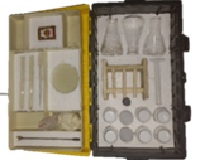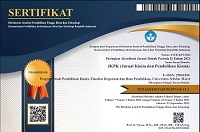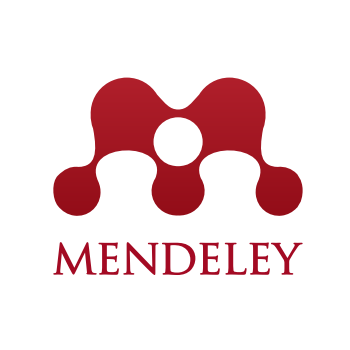
A Portable Laboratory Kit for Student Self-Learning on Factors That Affect Reactions
Abstract
In chemistry practicums, students can enhance their scientific thinking skills and develop scientific attitudes. However, in some underprivileged schools, particularly during the COVID-19 pandemic, practicum activities were restricted due to the unavailability of laboratory tools and materials. To address this issue, a portable laboratory kit was developed to support practical learning experiences. This study aims to develop a portable laboratory tool model, integrating the Predict-Observe-Explain (POE) approach, to improve students' learning outcomes on reaction rates. This research employs a mixed-methods approach with an embedded experimental model, utilizing a one-group pretest-posttest design. The portable laboratory kit includes hands-on tools and materials, student worksheets, and teacher guides aligned with POE learning syntax. Three experts conducted validation and implementation involving 24 high school students. A novelty of this study lies in the practical worksheet design, which follows the POE learning syntax and fosters intertextual relationships across macroscopic, submicroscopic, and symbolic representations. The findings reveal a significant difference between pretest and posttest scores regarding students' understanding of factors affecting reaction rates. Specifically, the number of students who demonstrated complete understanding after the intervention was: nine for the effect of structure on reaction rate, 13 for the effect of ionization energy on reaction rate, and 20 for the effect of surface area on reaction rate. Regarding catalysts, 15 students fully understood the effect of a homogeneous catalyst, and 18 students understood the effect of a heterogeneous catalyst. Interviews with teachers and students further indicated that students found the approach novel, motivating them to engage more deeply. Additionally, many students expressed feeling particularly challenged during the prediction stage of the POE learning process.
Keywords
Full Text:
PDFReferences
[1] V. Gkitzia et al., "Students’ competence in translating between different types of chemical representations," Chem. Educ. Res. Pract., vol. 21, pp. 207–330, 2020, doi: 10.1039/C8RP00301G.
[2] C. Stroumpouli, G. Tsaparlis, "Chemistry students’ conceptual difficulties and problem solving behaviour in chemical kinetics, as a component of an introductory physical chemistry course," Chem. Teach. Int., vol. 4 (3), pp. 279-296, 2022, doi: 10.1515/cti-2022-0005.
[3] A. Berg et al., "Representational challenges in animated chemistry: self-generated animations to encourage students’ reflections on sub-micro processes in laboratory exercises," Chem. Educ. Res. Pract., vol. 20, no. 4, pp. 710–737, 2019, doi: 10.1039/C8RP00288F.
[4] Y. Handayanti, A. Setiabudi, and Nahadi, "Analisis Profil Model Mental Siswa SMA pada Materi Laju Reaksi," J. Penelitian dan Pembelajaran IPA, vol. 1, no. 1, pp. 107–122, 2015, doi: 10.30870/jppi.v1i1.329.
[5] H. K. Wu, "Linking the Microscopic View of Chemistry to Real Life Experiences: Intertextuality in a High-school Science Classroom," Science Education, vol. 87, no. 6, pp. 868–891, 2003, doi: 10.1002/sce.10090.
[6] A. H. Johnstone, "Why is Science Difficult to Learn? Things are Seldom What They Seem," J. Comput. Assist. Learn., vol. 7, pp. 75–83, 1991, doi: 10.1111/j.1365-2729.1991.tb00230.x.
[7] D. Treagust et al., "The Role of Submicroscopic and Symbolic Representations in Chemical Explanations," Int. J. Sci. Educ., vol. 25, no. 11, pp. 1353–1368, 2003, doi: 10.1080/0950069032000070306.
[8] Li et al., "Application of Multiple Representation Levels in Redox Reactions among Tenth Grade Chemistry Teachers," J. Turk. Sci. Educ., vol. 11, no. 3, pp. 35–52, 2014, doi: 10.12973/tused.10117a.
[9] H. D. Barke, A. Hazari, and S. Yitbarek, Students’ Misconceptions and How to Overcome Them, Verlag Berlin Heidelberg: Springer, 2009, doi: 10.1007/978-3-540-70989-3_3.
[10] E. Yalcinkaya et al., "Is Case-Based Learning an Effective Teaching Strategy to Challenge," Res. Sci. Technol. Educ., vol. 30, no. 2, pp. 151–172, 2012, doi: 10.1080/02635143.2012.698605.
[11] O. T. Kirik and Y. Boz, "Cooperative Learning Instruction for Conceptual Change in the Concepts of Chemical Kinetics," Chem. Educ. Res. Pract., vol. 13, pp. 221–236, 2012, doi: 10.1039/c1rp90072b.
[12] Fahmi and Y. Irhasyuarna, "Misconception of Reaction Rates on High School Level in Banjarmasin," IOSR J. Res. Method Educ., vol. 7, no. 1, pp. 54–61, 2017, doi: 10.9790/7388-0701045461.
[13] A. W. Wijayadi, "Menggali Pemahaman Awal Mahasiswa Tingkat I pada Materi Laju Reaksi Menggunakan Instrumen Two Tier," J. Pemikiran, Penelitian Pendidikan dan Sains, vol. 5, no. 2, pp. 172–180, 2017, doi: 10.31102/wacanadidaktika.5.02.172-180.
[14] J. Jusniar et al., "Misconceptions in rate of reaction and their impact on misconceptions in chemical equilibrium," Eur. J. Educ. Res., vol. 9, no. 4, pp. 1405–1423, 2020, doi: 10.12973/eu-jer.9.4.1405.
[15] M. Nazar, S. Sulastri, S. Winarni, and R. Fitriana, "Identifikasi miskonsepsi siswa SMA pada konsep faktor-faktor yang mempengaruhi laju reaksi," J. Biol. Edukasi, vol. 2, no. 3, pp. 49–53, 2010, doi: 10.31227/osf.io/abcd1.
[16] L. A. Lestari, "Identifikasi miskonsepsi siswa pada materi laju reaksi dan perbaikannya menggunakan model pembelajaran learning cycle 5E dengan strategi konflik kognitif," J. Pendidikan: Teori, Penelitian, dan Pengembangan, vol. 6, no. 6, pp. 888–894, 2021, doi: 10.17977/jptpp.v6i6.14876.
[17] B. Bortnik, N. Stozhko, I. Pervukhina, A. Tchernysheva, and G. Belysheva, "Effect of Virtual Analytical Chemistry Laboratory on Enhancing Student Research Skills and Practices," Res. Learn. Technol., vol. 25, pp. 1–20, 2017, doi: 10.25304/rlt.v25.1968.
[18] H. T. Wong and S. F. Sim, "A Curriculum-based laboratory kit for flexible teaching and learning of practical chemistry," Chem. Teacher Int., vol. 4, no. 4, pp. 343–353, 2022, doi: 10.1515/cti-2022-0014.
[19] Izzania, R. Annisa, and E. Widhihastuti, "Potensi penggunaan kit praktikum dan video tutorial sebagai media pembelajaran jarak jauh," Chem. Educ., vol. 9, no. 2, 2020, [Online].
[20] R . Ramachandran et al., "Investigating the Effectiveness of Using Application-Based Science Education Videos in a General Chemistry Lecture Course," J. Chem. Educ., vol. 96, no. 9, pp. 479–485, 2019, doi: 10.1021/acs.jchemed.8b00777.
[21] A. R. Shelawaty, D. Hadiarti, and R. Fadhilah, "Pengembangan Media Flash Materi Ikatan Kimia Siswa Kelas X SMA Negeri 1 Pontianak," Ar-Razi J. Ilmiah, vol. 4, no. 2, pp. 11–22, 2016, doi: 10.29406/ar.v4i2.670.
[22] Putera et al., "Pengaruh metode belajar VAK dalam pembelajaran kooperatif tipe NHT untuk meningkatkan aktivitas siswa pada materi laju reaksi," Unesa J. Chem. Educ., vol. 10, no. 2, pp. 113–121, 2021, doi: 10.26740/ujced.v10n2.p113-121.
[23] N. Aulia, B. Yonata, and Ismono, "Guided Inquiry Implementation to Improve Critical Thinking Skills in Sub Matter Factors that Affect Reaction Rate in SMAN 2 Bangkalan," Unesa J. Chem. Educ., vol. 9, no. 1, pp. 148–157, 2020, doi: 10.26740/ujced.v9n1.p148-157.
[24] F. Syamsiana et al., "The Effectiveness of using POE (predict-observe-explain) Strategy on Students’ Learning Result of Reaction Rate Chapter in SMA," J. Penelitian Pendidikan Sains, vol. 7, no. 2, pp. 1507–1512, 2018, doi: 10.26740/jpps.v7n2.p1507-1512.
[25] I. Kibirige, J. Osodo, and K. M. Tlala, "The effect of predict-observe-explain strategy on learners’ misconceptions about dissolved salts," Mediterranean J. Soc. Sci., vol. 5, no. 4, pp. 300–310, 2014, doi: 10.5901/mjss.2014.v5n4p300.
[26] Warsono and Hariyanto, Pembelajaran Aktif: Teori dan Assesment, Bandung: PT. Remaja Rosdakarya, 2017.
[27] W. J. Creswell, Research Design: Pendekatan Kualitatif, Kuantitatif, dan Mixed, Yogyakarta: Pustaka Pelajar, 2013.
[28] R. Sundayana, Statistika Penelitian Pendidikan, Bandung: Alfabeta, 2016.
[29] R. White and R. Gunstone, Probing Understanding, New York: Routledge, 2014.
[30] S. A. Pohan, T. Widhiyanti, S. Mulyani, and W. Wiji, "Intertextual-Based Learning Strategy in Salt Hydrolysis Concept to Promote Students’ Concept Mastery and Scientific Process Skills," Proc. 4th Asian Educ. Symp. (AES 2019), Advances in Social Science, Education and Humanities Research, vol. 438, pp. 79–83, 2020, doi: 10.2991/assehr.k.200513.018.
[31] C. G. Che Kob, A. Shah, H. Shamsuddin, and N. A. A. Norizan, "The Effect of Using Learning Kit Material among Students," Int. J. Recent Technol. Eng., vol. 7, no. 6S2, pp. 239–242, 2019, doi: 10.35940/ijrte.F1036.0476S219.
[32] S. Haryati and D. Onggo, "Pembuatan Kit Praktikum Kimia Skala Kecil untuk Pembelajaran Reaksi Kimia," Prosiding SNIPS, Jul. 2016.
[33] A. C. Permana, "Lab Kit Development to Improve Student’s Attitudes and Achievements in Distance Learning," Eduproxima: J. Ilmiah Pendidikan IPA, vol. 4, no. 1, pp. 1–12, 2022, doi: 10.29100/eduproxima.v4i1.2760.
[34] C. C. Okam and I. I. Zakari, "Impact of Laboratory-Based Teaching Strategy on Students’ Attitudes and Mastery of Chemistry in Katsina Metropolis, Katsina State, Nigeria," Int. J. Innov. Res. Dev., vol. 6, no. 1, pp. 112–121, 2017.
Refbacks
- There are currently no refbacks.








